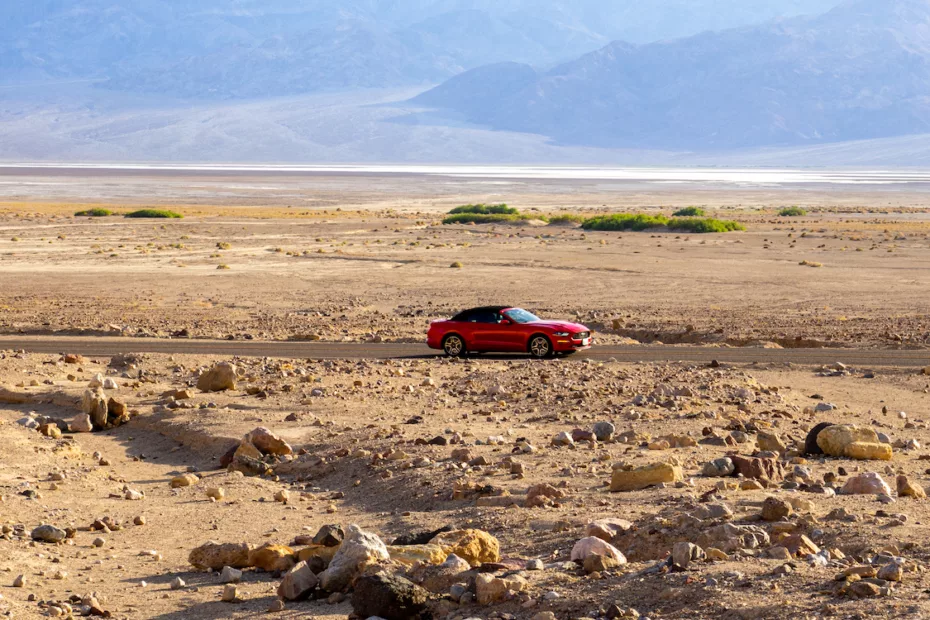Today, we’re heading to Death Valley National Park!
We wake up to sunshine on Tuesday, May 14, 2019. We’ve slept well, and the dreamy scenery in which we’re taking our first steps puts us in an excellent mood. We hadn’t planned to have breakfast, but we’re looking forward to having one on the road. It’s a journey of no less than six hours to Death Valley Junction, our next stop.
Off to Death Valley National Park!
With our bags packed, we greet our host and his partner’s son, who’s off to school in an old Buick. I wish I’d had a car like this when I was in high school…
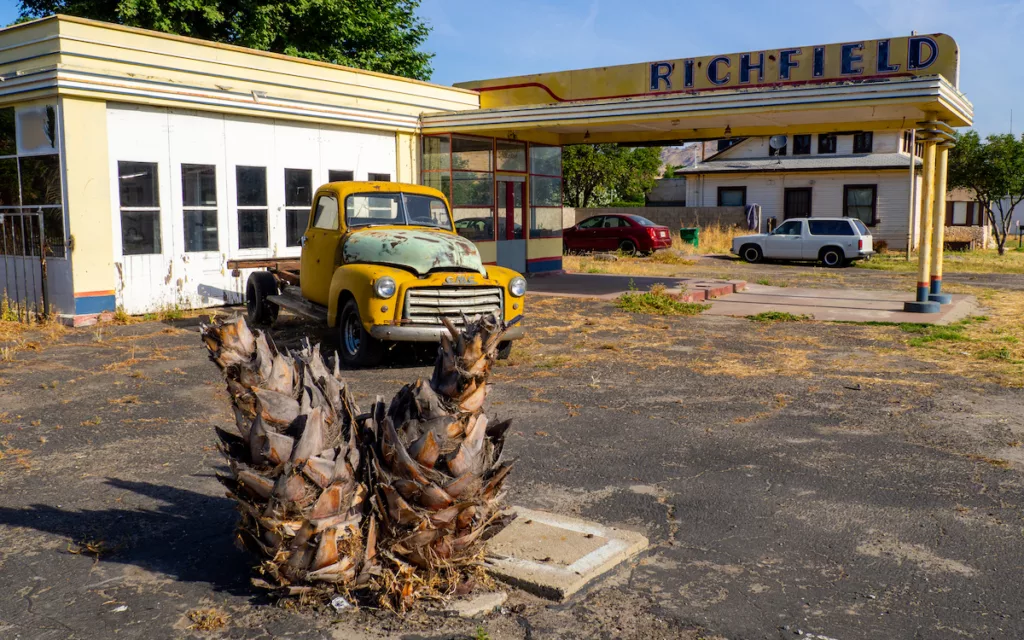
Stopover in Visalia
We take Route 198, which again takes us around Lake Kaweah. We drive to Visalia, where we hope to refuel and find a place to eat. During the short drive, we notice some old fire trucks parked on the side of the road, as well as some old pickups left as decoration in front of a disused gas station.
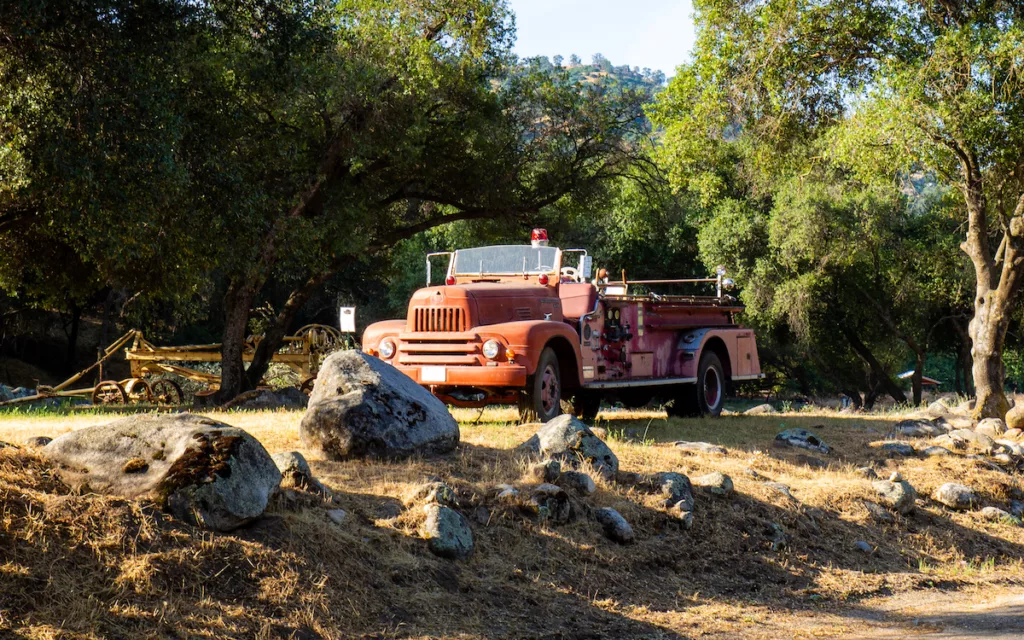
The Black Bear Diner
The Mitsubishi sated, we pull into the Black Bear Diner parking lot, hoping to do the same with our appetite. On one side of the wall is a gigantic painting. It depicts Sequoia National Park and a few brown bears, with a sign reading “Visalia, gateway to the sequoias“.
On arrival, we are greeted by a young woman who invites us to take a seat and consult the menu. The menu is presented in the form of a newspaper entitled “The Black Bear Gazette”, dated 1949. On the first page, we find current events and the company’s history. The second page is devoted to breakfast. We discover different dishes, each more appetizing than the last. We manage to make up our minds. It’s Avocado Toast for Sarah and a California Omelette for me.
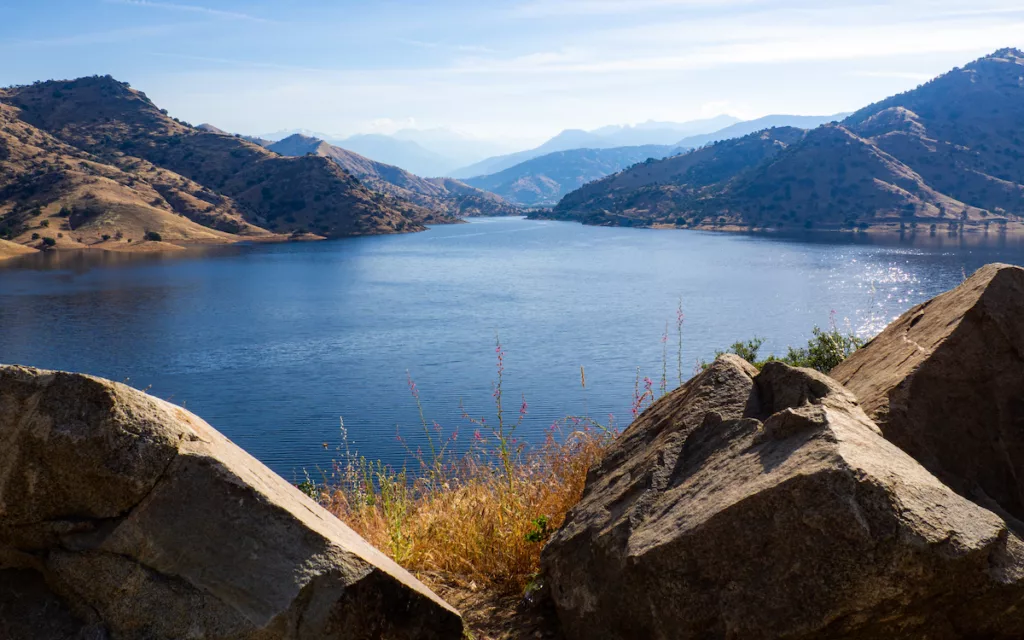
The history of the restaurant
We take advantage of the wait to discover the credo of the Black Bear Diner story written on our placemat. The story begins in 1861, when a gold prospector named Sisson discovered California’s Strawberry Valley. He fell in love with the place, settled down and opened an inn in Mt Shasta City. The inn overlooked the nearby wild berry patches, frequented at the time by both black bears and a few humans. Travelers, tired of their journey, got into the habit of dropping by the inn, where they knew that Sisson, the owner, always had generous, quality food in store for them, in a friendly atmosphere. That’s how the company’s first establishment was born.
By 1995, Bruce Dean and Bob & Laurie Manley were determined to revive the Black Bear Diner on the site where the inn had begun. Since then, many other similar diners have been built in other cities, but always with the same philosophy. Among the golden rules: a smiling waiter on arrival, menus prepared to order using fresh ingredients, “value for money”, and customer care, whether in the dining room or via comments received by e-mail or various platforms.
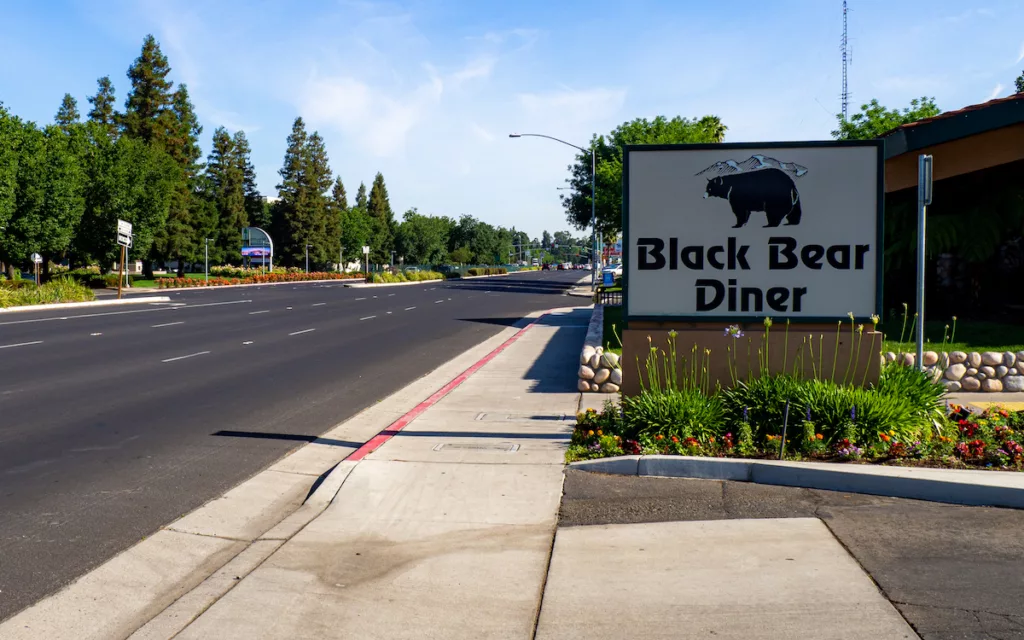
Breakfast for kings
We smile as our plates arrive. They’re more than generous. Sarah’s plate, an avocado toast served with two eggs Benedict and fresh fruit, is extra large. And the contents overflow! As for me, the omelette comes with brioche, fried potatoes, avocado, mushrooms and cheese. A cup of coffee bearing the restaurant’s logo helps me slide it all down. We manage to finish our plates, but we already know that a break at an In-N-Out today is out of the question!
A souvenir before leaving
When I go to pay, there’s a bit of a crowd in front of me. I take the opportunity to look at the store behind me. Sarah and I can’t resist giving our daughters a Black Bear bib.
In the parking lot, a brand-new Camaro RS and an old Ford pickup are parked side by side. The contrast is striking, but that’s common here.
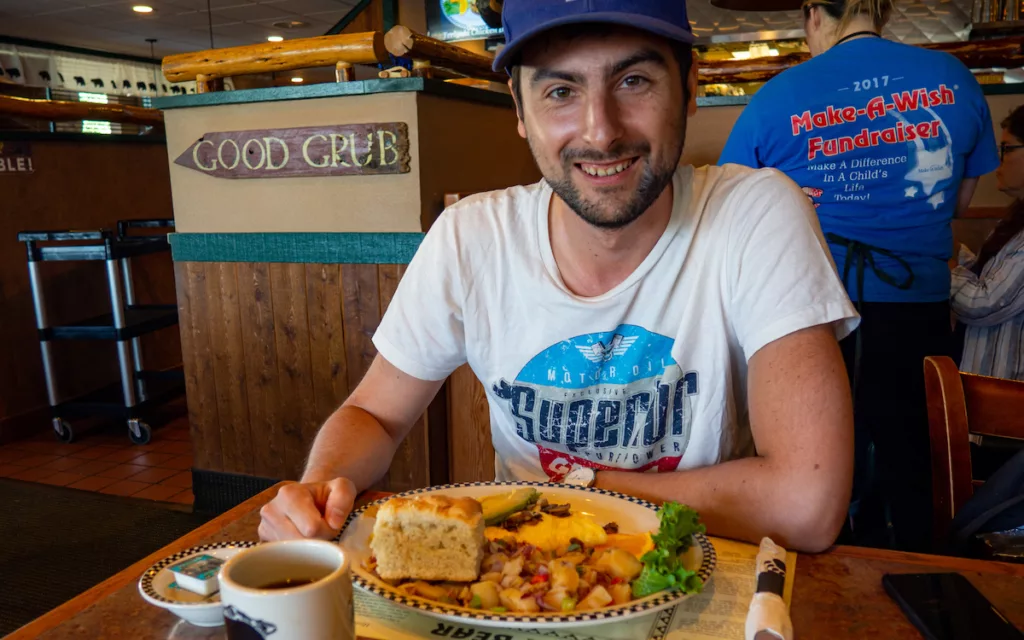
Cliché
Sarah and I then go to a supermarket to do some shopping. We buy a little over 2 gallons of water (about 10 liters), chips and cakes. We also pick up some canned Mac & Cheese for dinner. It’s a good opportunity to see the local “Housewives” out shopping. The cliché from Marc Cherry’s flagship comedy.
The Mojave Desert
To reach Death Valley, we have to drive for over 6 hours, or 367 miles. Along the way, we pass a truck carrying a dozen brand-new 2019 Mustangs! We also see the landscape change. It changes from forests and posh suburbs to a more arid desert landscape in the middle of the Mojave. On the same road, we’re lucky enough to see wind turbines the likes of which we’ve never seen before.
Baker
We stop for gas and a snack – finally – in the town of Baker, where we see the world’s largest thermometer. At the Arco station, no hello, no smile, not even a cordial tone. If the French tourist doesn’t understand us, that’s his problem. After what can only be described as a long and difficult exchange, we’re off again, while several owners of pickups with oversized wheels are having fun doing burnouts on the asphalt of the service station.
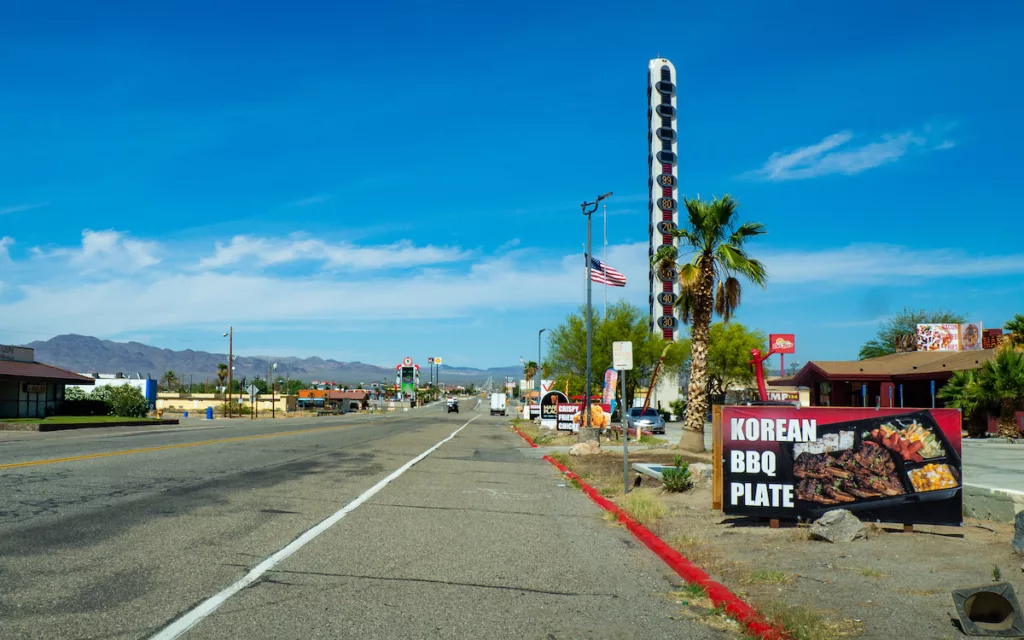
Amargosa Opera House and Hotel
Run by volunteers
An hour and a half later, we arrived at our destination: the Amargosa Opera House and Hotel. If any of the hotels on our trip is haunted, it’s this one. Located in Death Valley Junction, just outside Death Valley National Park, it’s run by volunteers who don’t stay overnight. It’s a place steeped in history, almost a hundred years old, where telephones don’t work, so it’s not very reassuring after dark.
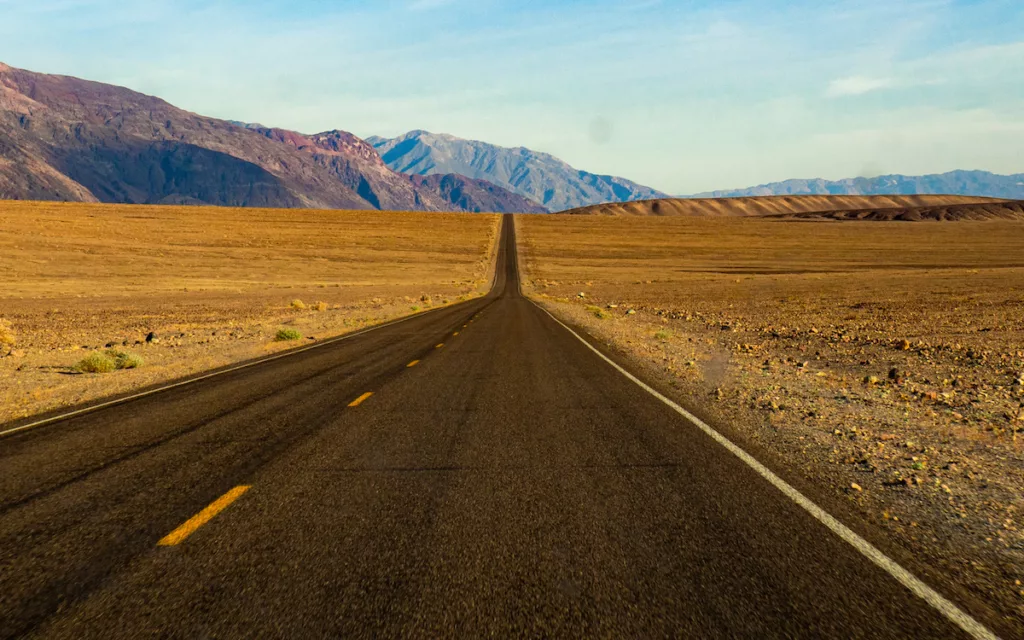
A welcoming place
However, the manager is very friendly and the room is clean and welcoming. We’re even greeted by two cats, a skinny black one and a larger white and brown one. The living room has green carpeting, a few paintings on the walls, a stone fireplace and a few sofas from another era. To the right, a long corridor where portraits seem to stare back at us as we pass takes us to the second bedroom.
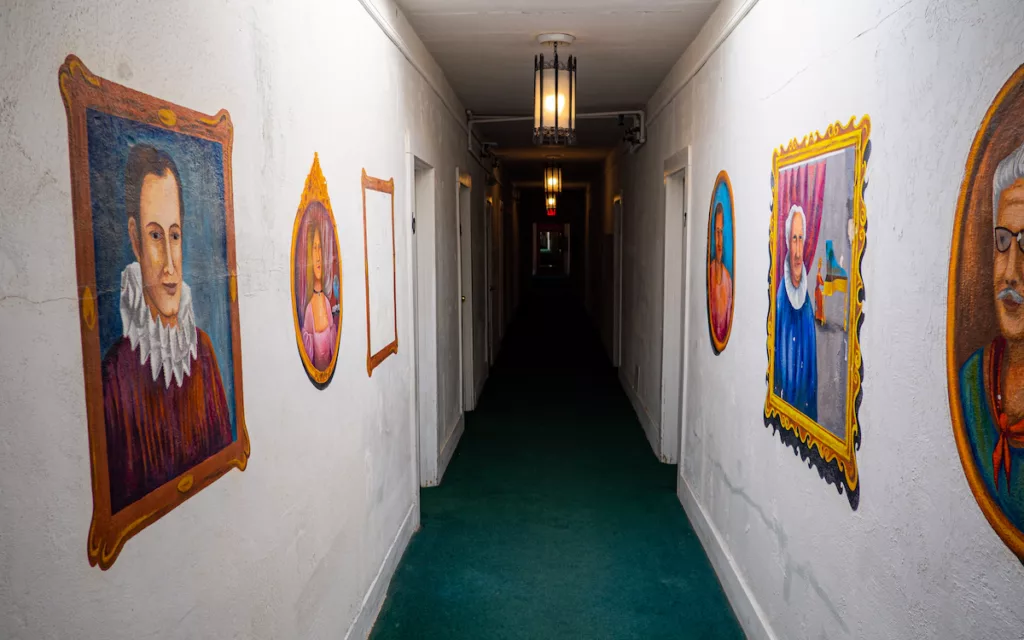
Room number 5
Ours – number 5 – has a large double bed with a flower-patterned overcoat. A desk, a chair – right up against the side of the bed where I sleep – a table and a bedside lamp make up the furniture. French window gives access to the front of the building, where we’ve parked the SUV. A bathroom completes the room. Green and yellow tiles add a splash of color. The shower, sink and toilet seem solid, despite a note to our attention: the plumbing is original and should be treated with respect.
Opposite the hotel is an old building, with only a few letters painted on the facade to identify it as a garage. We return to the car for our first visit to Death Valley National Park.
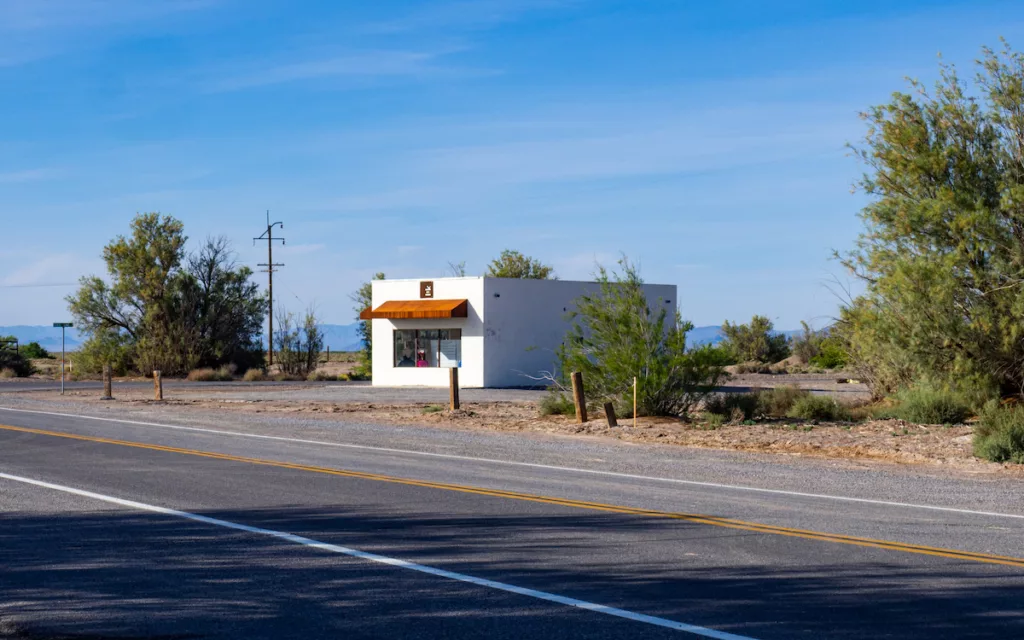
The weather in Death Valley
Death Valley is one of the hottest places in the world, with summer temperatures often reaching 120°F and night-time temperatures often not dropping below 100°F. The highest recorded ground temperature was 200°F at Furnace Creek on July 15, 1972, while the maximum air temperature that day was 127°F. This extreme heat is due to the desert sun penetrating the valley, whose mountain walls trap the rising hot air and release it towards the basin.
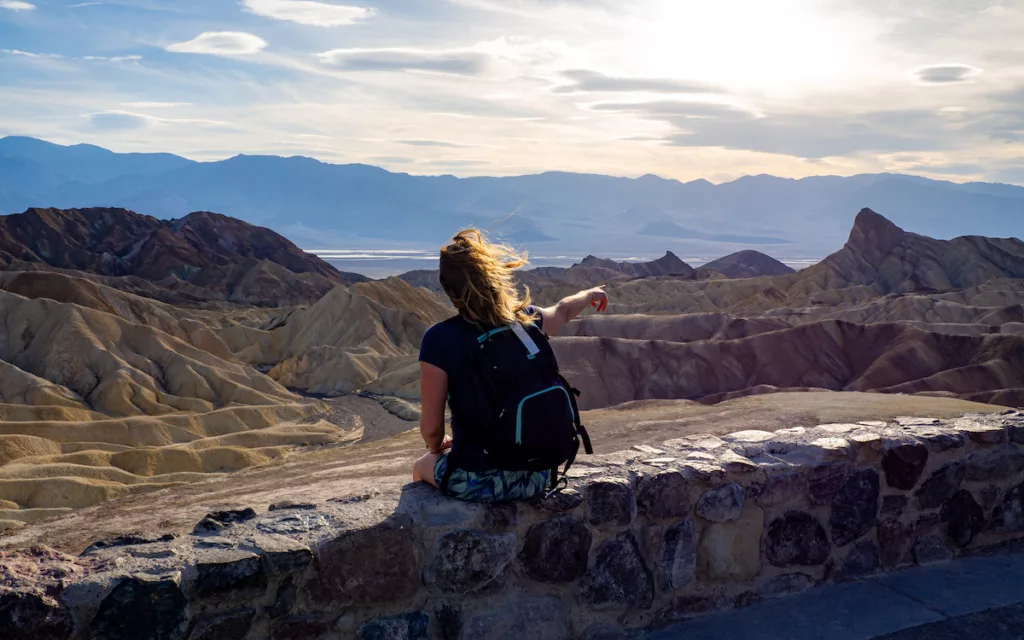
The area is also one of the driest in North America, with less than 5 cm of rainfall per year on average. To illustrate this point, here’s what the hottest summers in this area look like: the greatest number of consecutive days with a maximum temperature of 100°F or more is 15 days (summer 2001). In 1917, there were 43 consecutive days with a temperature of 120°F or more. There were 40 days above 120°F in 1996 and 105 days above 110°F.
In contrast to the extremes of summer, winter and spring in Death Valley are considered pleasant. Winter temperatures are milder, with cool nights that only occasionally reach 32°F. Also, while sunny skies can be considered the norm in Death Valley, winter storms and summer monsoons can occur.
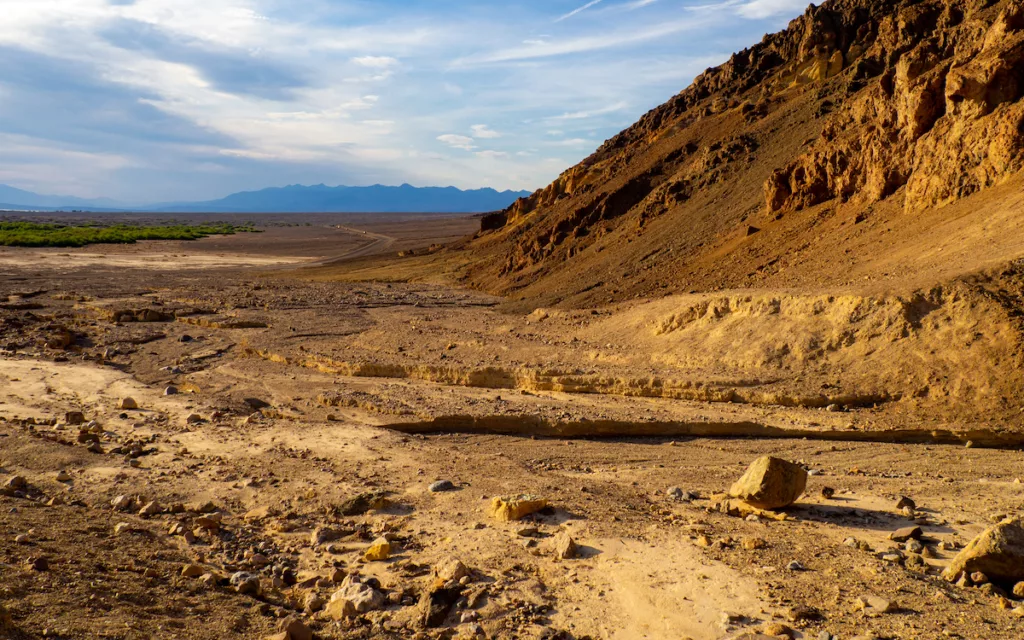
First visit to Death Valley National Park
Zabriskie Point and Golden Canyon
Our first stop is in front of the sign announcing Death Valley National Park. Then it’s on to Zabriskie Point. Once the bed of a lake, this area has been dry for millions of years. Over time, the soils have been subjected to various stresses from water, volcanoes and earthquakes, to end up like this today. Our route then takes us past Golden Canyon, which creates a landscape of golden hills and narrow, winding canyons, particularly beautiful on this late afternoon.
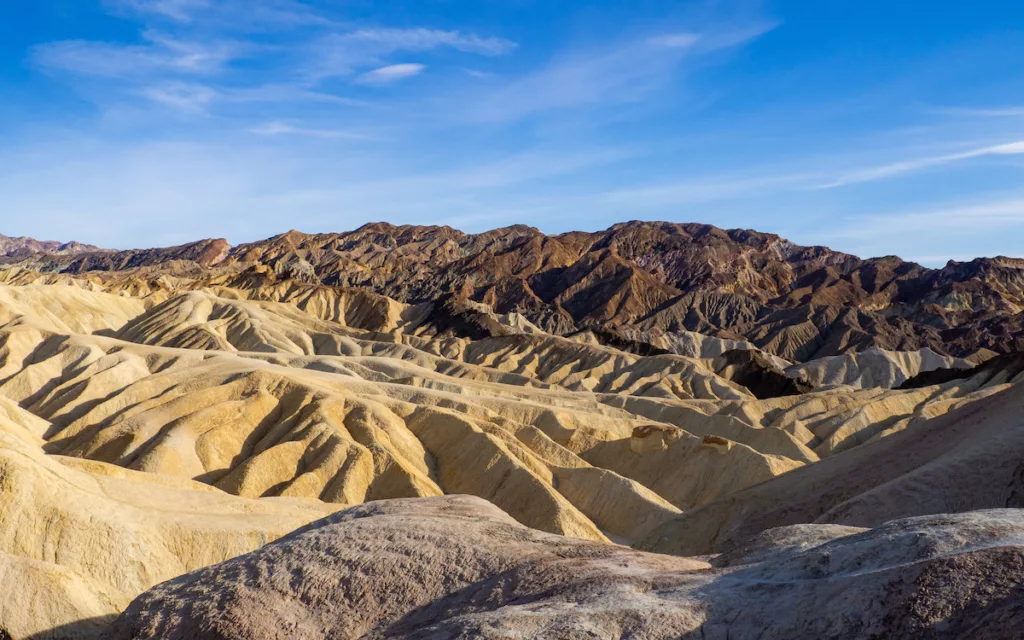
Devil Golf Course
We head a little further into Death Valley to Devil Golf Course, passing a resort with far too much greenery for the location. The Devil Golf Course was once covered by a lake. The salt that makes up the course’s soil today is composed of minerals from that lake.
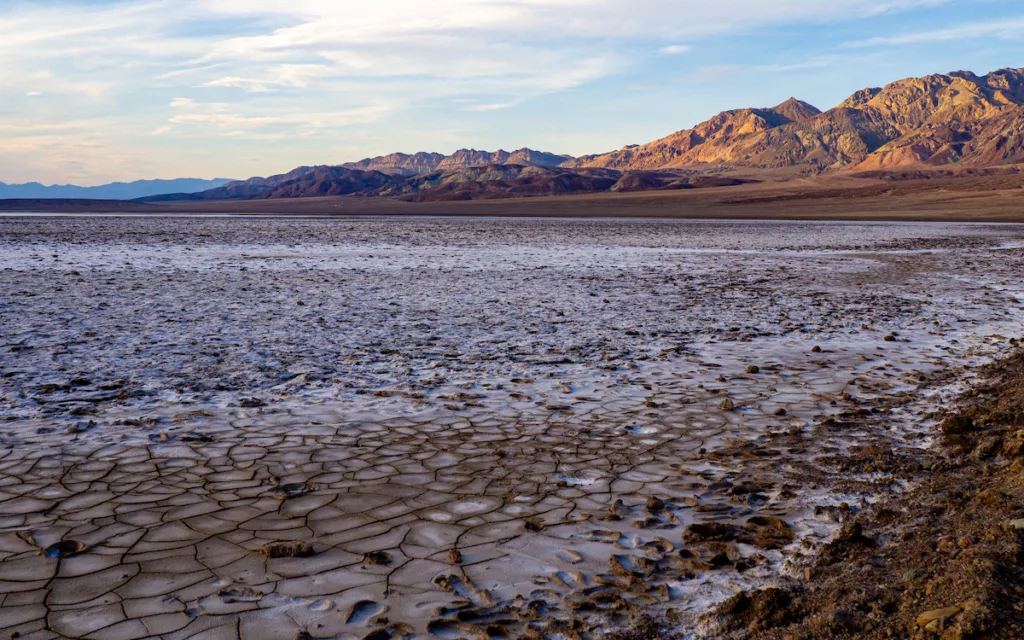
Badwater Basin
Finally, we head for Badwater Basin, 85.5 metres below sea level! We walk on what the eye thinks is sand, but is actually salt. Water is scarce and precious here. So, as one sign says, imagine the disappointment when a surveyor mapping this area fails to get his mule to drink from this basin. On his map, he wrote that this water source was “bad water”. That’s how the name stuck. The water in the basin is not toxic, just salty. The pond is home to pickles, aquatic insects, larvae and a rare animal: the Badwater snail.
We spend some time here, marvelling at the sunset and the colors it casts on the rock. I open a beer – not very cold – bought this morning at the supermarket before heading back to our hotel.
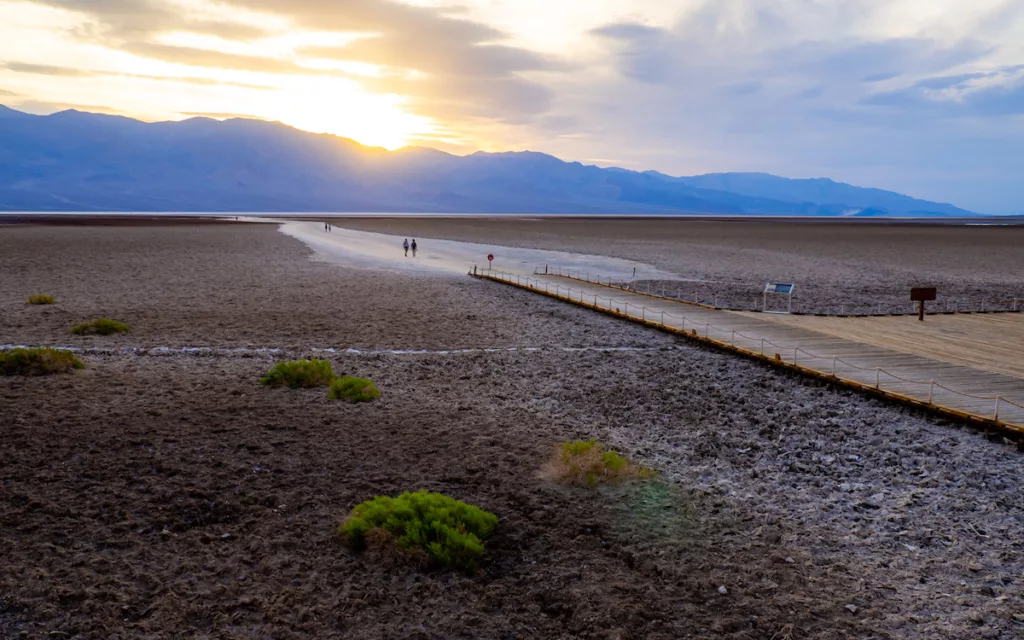
Back to the hotel
It’s only May, but we’ve still reached 102°F by the end of the day. I’d love to stay longer and see the night fall, to listen to the silence, feel the darkness, admire the Milky Way, or hear the sound of animals as the temperatures cool. Alas, Sarah and I are exhausted from a long day on the road. We return only a few minutes after the sun has gone down.
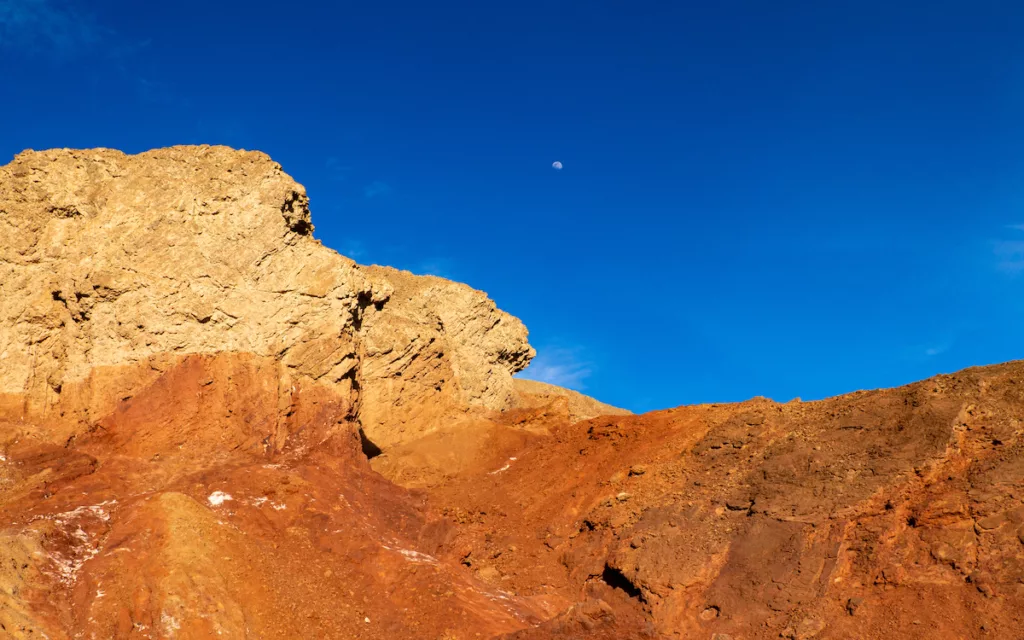
The awful Mac & Cheese
Back at the hotel, we try to eat the Mac & Cheese cooked in the microwave in the common room. It’s awful, and we fall back on a few of our reserves. I then write the article on my blog and we go to bed.
The day in review
Today we covered 460 miles by car and only 5,790 steps (3 miles). We did, however, eat a lot of calories (1,270 for me, with breakfast alone). Tomorrow promises to be a busy day with a surprise! That’s all I can tell you.


